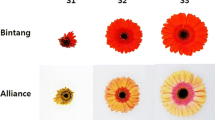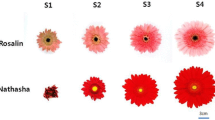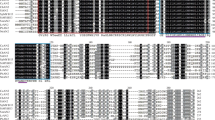Abstract
The study was aimed to identify the factors that regulate the intensity of flower color in cyanic dahlia (Dahlia variabilis), using fifteen cultivars with different color intensities in their petals. The cultivars were classified into three groups based on their flavonoid composition: ivory white cultivars with flavones; purple and pink cultivars with flavones and anthocyanins; and red cultivars with flavones, anthocyanins, and chalcones. Among the purple, pink, and ivory white cultivars, an inverse relationship was detected between lightness, which was used as an indicator for color intensity and anthocyanin content. A positive correlation was detected between anthocyanin contents and the expression of some structural genes in the anthocyanin synthesis pathway that are regulated by DvIVS, a basic helix-loop-helix transcription factor. A positive correlation between anthocyanin content and expression of DvIVS was also found. The promoter region of DvIVS was classified into three types, with cultivars carrying Type 1 promoter exhibited deep coloring, those carrying Type 2 and/or Type 3 exhibited pale coloring, and those carrying Type 1 and Type 2 and/or Type 3 exhibited medium coloring. The transcripts of the genes from these promoters encoded full-length predicted proteins. These results suggested that the genotype of the promoter region in DvIVS is one of the key factors determining the flower color intensity.








Similar content being viewed by others
Abbreviations
- ANS:
-
Anthocyanidin synthase
- bHLH:
-
Basic helix-loop-helix
- CHI:
-
Chalcone isomerase
- CHS:
-
Chalcone synthase
- DFR:
-
Dihydroflavonol 4-reductase
- F3H:
-
Flavanone 3-hydroxylase
- FNS:
-
Flavone synthase
- HPLC:
-
High-performance liquid chromatography
- WDR:
-
WD-repeat
References
Azuma A, Udo Y, Sato A, Mitani N, Kono A, Ban Y, Yakushiji H, Koshita Y, Kobayashi S (2011) Haplotype composition at the color locus is a major genetic determinant of skin color variation in Vitis × labruscana grapes. Theor Appl Genet 122:1427–1438
Bai Y, Pattanaik S, Patra B, Werkman JR, Xie CH, Yuan L (2011) Flavonoid-related basic helix-loop-helix regulators, NtAn1a and NtAn1b, of tobacco have originated from two ancestors and are functionally active. Planta 234:363–375
Bate-Smith EC, Swain T (1953) The isolation of 2′,4,4′-trihydroxychalkone from yellow varieties of Dahlia variabilis. J Chem Soc, 2185–2187
Bate-Smith EC, Swain T, Nördstrom CG (1955) Chemistry and inheritance of flower colour in the Dahlia. Nature 176:1016–1018
Comai L (2005) The advantages and disadvantages of being polyploid. Nat Rev Gen 6:836–846
Deguchi A, Ohno S, Hosokawa M, Tatsuzawa F, Doi M (2013) Endogenous post-transcriptional gene silencing of flavone synthase resulting in high accumulation of anthocyanins in black dahlia cultivars. Planta 237:1325–1335
Dubos C, Le Gourrierec J, Baudry A, Huep G, Lanet E, Debeaujon I, Routaboul J-, Alboresi A, Weisshaar B, Lepiniec L (2008) MYBL2 is a new regulator of flavonoid biosynthesis in Arabidopsis thaliana. Plant J 55:940–953
Fujioka M, Kato M, Kakihara F, Tokumasu S (1991) Anthocyanidin composition of petals in Pelargonium × domesticum Baiey. J Jpn Soc Hortic Sci 59:823–831
Gatt M, Ding H, Hammett K, Murray B (1998) Polyploidy and evolution in wild and cultivated Dahlia species. Ann Bot 81:647–656
Grotewold E (2006) The genetics and biochemistry of floral pigments. Annu Rev Plant Biol 57:761–780
Harborne JB, Greenham J, Eagles J (1990) Malonylated chalcone glycosides in Dahlia. Phytochemistry 29:2899–2900
Hashimoto F, Tanaka M, Maeda H, Shimizu K, Sakata Y (2000) Characterization of cyanic flower color of Delphinium cultivars. J Jpn Soc Hortic Sci 69:428–434
Hichri I, Barrieu F, Bogs J, Kappel C, Delrot S, Lauvergeat V (2011) Recent advances in the transcriptional regulation of the flavonoid biosynthetic pathway. J Exp Bot 62:2465–2483
Kobayashi S (2009) Regulation of anthocyanin biosynthesis in grapes. J Jpn Soc Hortic Sci 78:387–393
Kobayashi S, Ishimaru M, Hiraoka K, Honda C (2002) Myb-related genes of the Kyoho grape (Vitis labruscana) regulate anthocyanin biosynthesis. Planta 215:924–933
Kobayashi S, Goto-Yamamoto N, Hirochika H (2005) Association of VvmybA1 gene expression with anthocyanin production in grape (Vitis vinifera) skin-color mutants. J Jpn Soc Hortic Sci 74:196–203
Koes R, Verweij W, Quattrocchio F (2005) Flavonoids: a colorful model for the regulation and evolution of biochemical pathways. Trends Plant Sci 10:236–242
Laitinen RAE, Ainasoja M, Broholm SK, Teeri TH, Elomaa P (2008) Identification of target genes for a MYB-type anthocyanin regulator in Gerbera hybrida. J Exp Bot 59:3691–3703
Lawrence WJC (1929) The genetics and cytology of Dahlia species. J Genet 21:125–159
Lawrence WJC, Scott-Honcrieff R (1935) The genetics and chemistry of flower colour in Dahlia: a new theory of specific pigmentation. J Genet 30:155–226
Mato M, Onozaki T, Ozeki Y, Higeta D, Itoh Y, Hisamatsu T, Yoshida H, Shibata M (2001) Flavonoid biosynthesis in pink-flowered cultivars derived from ‘William Sim’ carnation (Dianthus caryophyllus). J Jpn Soc Hortic Sci 70:315–319
Matsui K, Umemura Y, Ohme-Takagi M (2008) AtMYBL2, a protein with a single MYB domain, acts as a negative regulator of anthocyanin biosynthesis in Arabidopsis. Plant J 55:954–967
McClaren B (2009) Encyclopedia of DAHLIAS. Timber Press, Portland
Mol J, Grofewold E, Koes R (1998) How genes paint flowers and seeds. Trends Plant Sci 3:212–217
Murray MG, Thompson WF (1980) Rapid isolation of high molecular weight plant DNA. Nucl Acids Res 8:4321–4325
Nesi N, Debeaujon I, Jond C, Pelletier G, Caboche M, Lepiniec L (2000) The TT8 gene encodes a basic helix-loop-helix domain protein required for expression of DFR and BAN genes in Arabidopsis siliques. Plant Cell 12:1863–1878
Noda KI, Glover BJ, Linstead P, Martin C (1994) Flower colour intensity depends on specialized cell shape controlled by a Myb-related transcription factor. Nature 369:661–664
Nordström CG, Swain T (1953) The flavonoid glycosides of Dahlia variabilis. Part I. General introduction. Cyanidin, apigenin, and luteolin glycosides from the variety “Dandy”. J Chem Soc, 2764–2773
Nordström CG, Swain T (1956) The flavonoid glycosides of Dahlia variabilis. II. Glycosides of yellow varieties Pius IX and Coton. Arch Biochem Biophys 60:329–344
Nordström CG, Swain T (1958) The flavonoid glycosides of Dahlia variabilis. III. Glycosides from white varieties. Arch Biochem Biophys 73:220–223
Ohno S, Hosokawa M, Hoshino A, Kitamura Y, Morita Y, Park K, Nakashima A, Deguchi A, Tatsuzawa F, Doi M, Iida S, Yazawa S (2011a) A bHLH transcription factor, DvIVS, is involved in regulation of anthocyanin synthesis in dahlia (Dahlia variabilis). J Exp Bot 62:5105–5116
Ohno S, Hosokawa M, Kojima M, Kitamura Y, Hoshino A, Tatsuzawa F, Doi M, Yazawa S (2011b) Simultaneous post-transcriptional gene silencing of two different chalcone synthase genes resulting in pure white flowers in the octoploid dahlia. Planta 234:945–958
Park KI, Ishikawa N, Morita Y, Choi JD, Hoshino A, Iida S (2007) A bHLH regulatory gene in the common morning glory, Ipomoea purpurea, controls anthocyanin biosynthesis in flowers, proanthocyanidin and phytomelanin pigmentation in seeds, and seed trichome formation. Plant J 49:641–654
Pattanaik S, Kong Q, Zaitlin D, Werkman JR, Xie CH, Patra B, Yuan L (2010) Isolation and functional characterization of a floral tissue-specific R2R3 MYB regulator from tobacco. Planta 231:1061–1076
Price JR (1939) The yellow colouring matter of Dahlia variabilis. J Chem Soc, 1017–1018
Quattrocchio F, Verweij W, Kroon A, Spelt C, Mol J, Koes R (2006) PH4 of petunia is an R2R3 MYB protein that activates vacuolar acidification through interactions with basic-helix-loop-helix transcription factors of the anthocyanin pathway. Plant Cell 18:1274–1291
Spelt C, Quattrocchio F, Mol JNM, Koes R (2000) Anthocyanin 1 of Petunia encodes a basic helix-loop-helix protein that directly activates transcription of structural anthocyanin genes. Plant Cell 12:1619–1631
Takeda K, Harborne JB, Self R (1986) Identification and distribution of malonated anthocyanins in plants of the compositae. Phytochemistry 25:1337–1342
Tanaka Y, Sasaki N, Ohmiya A (2008) Biosynthesis of plant pigments: anthocyanins, betalains and carotenoids. Plant J 54:733–749
Uddin AFMJ, Hashimoto F, Miwa T, Ohbo K, Sakata Y (2004) Seasonal variation in pigmentation and anthocyanidin phenetics in commercial Eustoma flowers. Sci Hortic 100:103–115
Yamagishi M, Yoshida Y, Nakayama M (2012) The transcription factor LhMYB12 determines anthocyanin pigmentation in the tepals of Asiatic hybrid lilies (Lilium spp.) and regulates pigment quantity. Mol Breed 30:913–925
Yoshida K, Kondo T, Okazaki Y, Katou K (1995) Cause of blue petal colour. Nature 373:291
Zhu HF, Fitzsimmons K, Khandelwal A, Kranz RG (2009) CPC, a single-repeat R3 MYB, is a negative regulator of anthocyanin biosynthesis in Arabidopsis. Mol Plant 2:790–802
Author information
Authors and Affiliations
Corresponding authors
Electronic supplementary material
Below is the link to the electronic supplementary material.
Rights and permissions
About this article
Cite this article
Ohno, S., Deguchi, A., Hosokawa, M. et al. A basic helix-loop-helix transcription factor DvIVS determines flower color intensity in cyanic dahlia cultivars. Planta 238, 331–343 (2013). https://doi.org/10.1007/s00425-013-1897-x
Received:
Accepted:
Published:
Issue Date:
DOI: https://doi.org/10.1007/s00425-013-1897-x




